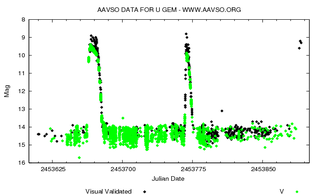U Geminorum
|
Double star U Geminorum |
|||||||||
|---|---|---|---|---|---|---|---|---|---|

|
|||||||||
| Brightness curve of U Geminorum | |||||||||
| AladinLite | |||||||||
|
Observation dates equinox : J2000.0 , epoch : J2000.0 |
|||||||||
| Constellation | Twins | ||||||||
| Right ascension | 07 h 55 m 5.23 s | ||||||||
| declination | + 22 ° 00 ′ 5 ″ | ||||||||
| Apparent brightness | 8.2 to 14.9 mag | ||||||||
| Typing | |||||||||
| B − V color index | 0.76 | ||||||||
| Spectral class | pec (UG) + M4.5V | ||||||||
| Variable star type | UGSS + E | ||||||||
| Astrometry | |||||||||
| Radial velocity | +42 km / s | ||||||||
| parallax | (10.71 ± 0.03) mas | ||||||||
| distance | (304.33 ± 0.85) Lj (93.3524 ± 0.2606) pc |
||||||||
| Proper movement | |||||||||
| Rec. Share: | (−27.36 ± 0.05) mas / a | ||||||||
| Dec. portion: | (−40.40 ± 0.03) mas / a | ||||||||
| Physical Properties | |||||||||
| Dimensions | (1.20 ± 0.05 / 0.42 ± 0.04) M ☉ | ||||||||
| radius | (~ 0.008 / 0.43 ± 0.06) R ☉ | ||||||||
| Rotation time | 4.24575 h | ||||||||
|
Other names and catalog entries |
|||||||||
|
|||||||||
U Geminorum also U Gem was discovered in 1855 by the British astronomer John Russell Hind . It is a cataclysmically variable binary star system , consisting of a red dwarf and a white dwarf in the constellation Gemini . The system wasclassifiedas a dwarf nova, and forms the prototype of the so-called U-Geminorum stars . However, the star itself is also included in the subgroup of the SS Cygni stars and together with it forms the prototype of this subgroup.
The binary star system around 300 light years away consists of a white dwarf and a red dwarf . These two components circle each other in 4 hours and 11 minutes. This results in a light change between 14.0 and 15.1 mag, which is mainly a consequence of the changeability of the cover .
In the event of an outbreak of brightness that occurs on average every 100 days, the apparent brightness can increase by up to 9 mag. The cycle is very irregular, with the shortest period between two outbreaks being 62 days, while the longest was 257 days in coming.
Even if U Geminorum is the prototype of the U Geminorum stars, there was a super maximum in 1985 with superhumps , which are typical of another subgroup of dwarf novae, the SU UMa stars .
Web links
Individual evidence
- ↑ a b c d e f U Gem. In: SIMBAD . Center de Données astronomiques de Strasbourg , accessed April 27, 2019 .
- ↑ a b c d U Gem. In: VSX. AAVSO, accessed April 27, 2019 .
- ↑ Echevarría, Juan: U Geminorum: A Test Case for Orbital Parameter Determination . In: The Astronomical Journal . 134, No. 1, 2007. arxiv : 0704.1641 . bibcode : 2007AJ .... 134..262E . doi : 10.1086 / 518562 .
- ^ Naylor, T .: The masses, radii and luminosities of the components of U Geminorum . In: Monthly Notices of the Royal Astronomical Society . 361, No. 3, 2005. arxiv : astro-ph / 0506351 . bibcode : 2005MNRAS.361.1091N . doi : 10.1111 / j.1365-2966.2005.09262.x .